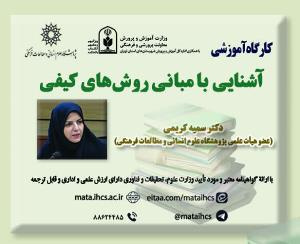الگوهای تعامل زناشویی افراد تمایزنایافته: یک مطالعه کیفی (مقاله علمی وزارت علوم)
درجه علمی: نشریه علمی (وزارت علوم)
آرشیو
چکیده
وجود تفاوت در تعاملات زوجی به واسطه ویژگی های درون فردی و بین فردی زوج ها است . شناسایی الگوهای تعاملی زوج ها در بستر تمایز نایافتگی هدف اصلی پژوهش حاضر است. این پژوهش با استفاده از روش کیفی و طرح پدیدارشناسی انجام گرفت. مشارکت کنندگان شامل 11 زن و 7 مرد بودند که نمرات تمایزیافتگی آنها یک انحراف استاندارد پایین تر از میانگین و اضطراب آنان یک انحراف استاندارد بالاتر از میانگین بود. انتخاب مشارکت کنندگان با استفاده از نمونه گیری هدفمند و روش ملاک محور انجام شد و جمع آوری اطلاعات از طریق مصاحبه نیمه ساختاریافته صورت گرفت. همچنین، به منظور پوشش دادن ملاک های ورود از مقیاس تمایزیافتگی اسکورن و فریدلندر و پرسشنامه سلامت عمومی استفاده گردید. مصاحبه ها طبق رویکرد هفت مرحله ای دیکلمن مورد کدگذاری و تحلیل قرار گرفت. تجزیه و تحلیل مصاحبه ها، منجر به شناسایی تعداد 118 کد اولیه شد که بر اساس شباهت معنایی، در 14 زیرطبقه قرار گرفت. سپس مفاهیم مرتبط با هم در 5 طبقه اصلی دسته بندی شدند که عبارتند از: 1- الگوهای تعاملی منفعل ساز 2- الگوهای تعاملی خصمانه 3- الگوهای تعاملی کنترل گرانه 4- الگوهای تعاملی مبتنی بر سلب مسئولیت 5- الگوهای مبتنی بر عدم درک دیدگاه مقابل. این پژوهش بر نقش تمایزیافتگی در الگوهای تعامل زناشویی تاکید می کند. به علاوه نتایج نشان دهنده وجود الگوهای مخرب تعامل زناشویی در افراد نامتمایز می باشد.Patterns of Marital Interaction of Undifferentiated Individuals: A qualitative study
The existence of differences in couple interactions is due to the intrapersonal and interpersonal characteristics of couples. The aim of this study is identify patterns of marital interaction in the context of undifferentiated. This research was conducted using qualitative method and phenomenological design. Participants included 11 females and 7 males whose differentiation scores were one standard deviation below average and whose anxiety was one standard deviation above average. Participants were selected by using purposive sampling and Criterion-based method. Data collection was made through semi - structured interview. Also, scales of Skowron and Friedlander differentiation and General Health Questionnaire were used to cover the inclusion criteria. The interviews were coded and analyzed according to Dickelmann's seven-step approach. The analysis of the interviews led to the identification of 118 initial codes, Based on semantic similarity, it was classified into 14 subcategory. Then related concepts were categorized into 5 main categories, which are: Passivity constructor interactive patterns, 2- Hostile interactive patterns, 3- Controlling interactive patterns, 4- Responsibility-oriented interactive patterns, 5- Patterns based on Lack of understanding another point of view. This study emphasizes the role of differentiation of self in marital interaction patterns. In addition, the results indicate the existence of destructive patterns of marital interaction in undifferentiated individuals.







